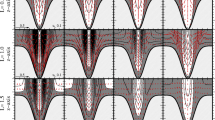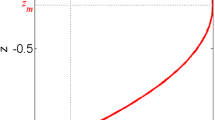Abstract
The 3D structure of the tide-induced Lagrangian residual current was studied using the particle image velocimetry (PIV) technique in a long shallow narrow tank in the laboratory. At the mouth of the tank, a wave generator was used to make periodic wave which represents the tide movement, and at the head of the tank, a laterally sloping topography with the length of one fifth of the water tank was installed, above which the tide-induced Lagrangian residual current was studied. Under the weakly nonlinear condition in the present experiment setup, the results show that the Lagrangian residual velocity (LRV) field has a three-layer structure. The residual current flows inwards (towards the head) in the bottom layer and flows outwards in the middle layer, while in the surface layer, it flows inwards along the shallow side of the sloping topography and outwards along the deep side. The depth-averaged and breadth-averaged LRV are also analyzed based on the 3D LRV observations. Our results are in good agreement with the previous experiment studies, the analytical solutions with similar conditions and the observational results in real bays. Moreover, the volume flux comparison between the Lagrangian and Eulerian residual currents shows that the Eulerian residual velocity violates the mass conservation law while the LRV truly represents the inter-tidal water transport. This work enriches the laboratory studies of the LRV and offers valuable references for the LRV studies in real bays.







Similar content being viewed by others
References
Abbot MR (1960) Boundary layer effects in estuaries. J Mar Res 18:83–100
Adrian RJ (2005) Twenty years of particle image velocimetry. Exp Fluids 39:159–169. https://doi.org/10.1007/s00348-005-0991-7
Aristizábal M, Chant R (2013) A numerical study of salt fluxes in Delaware Bay estuary. J Phys Oceanogr 43:1572–1588
Burchard H, Schuttelaars HM (2012) Analysis of tidal straining as driver for estuarine circulation in well-mixed estuaries. J Phys Oceanogr 42(2):261–271
Dalziel Research Partners (2012) DigiFlow user guide. Dalziel Research Partners, Cambridge
Feng SZ (1987) A three-dimensional weakly nonlinear model of tide-induced Lagrangian residual current and mass transport, with an application to the Bohai Sea. In: Nihoul JCJ, Jamart BM (eds) Three-dimensional models of marine and estuarine dynamics, Elsevier oceanography series, 45. Elsevier, Amsterdam, pp 471–488
Feng SZ (1990) On the Lagrangian residual velocity and the mass-transport in a multi-frequency oscillatory system. In: Cheng RT (ed) Residual currents and long-term transport. Coastal and estuarine studies. Coastal and estuarine studies. Springer New York, Berlin, pp 34–48
Feng SZ, Lu YY (1993) A turbulent closure model of coastal circulation. Chin Sci Bull 38:1737–1741
Feng SZ, Wu DX (1995) An inter-tidal transport equation coupled with turbulent k-ε model in a tidal and quasi-steady current system. Chin Sci Bull 40:136–139
Feng SZ, Xi PG, Zhang SZ (1984) The baroclinic residual circulation in shallow seas I. The hydrodynamic models. Chin J Oceanol Limnol 2:49–60
Feng SZ, Cheng RT, Xi PG (1986a) On tide-induced Lagrangian residual current and residual transport: 1. Lagrangian residual current. Water Resour Res 22:1623–1634
Feng SZ, Cheng RT, Xi PG (1986b) On tide-induced Lagrangian residual current and residual transport: 2. Residual transport with application in South San Francisco Bay. Water Resour Res 22:1635–1646
Feng SZ, Ju L, Jiang WS (2008) A Lagrangian mean theory on coastal sea circulation with inter-tidal transports, I. Fundamentals. Acta Oceanol Sin 27:1–16
Fischer HB, List EJ, Koh R et al (1979) Mixing in inland and coastal waters. Academic, New York
Ianniello JP (1977) Tidally induced residual currents in estuaries of constant breadth and depth. J Mar Res 35:755–786
Ianniello JP (1979) Tidally induced residual currents in estuaries of variable breadth and depth. J Phys Oceanogr 9:962–974
Jiang WS, Feng SZ (2011) Analytical solution for the tidally induced Lagrangian residual current in a narrow bay. Ocean Dyn 61:543–558. https://doi.org/10.1007/s10236-011-0381-z
Jiang WS, Feng SZ (2014) 3D analytical solution to the tidally induced Lagrangian residual current equations in a narrow bay. Ocean Dyn 64:1073–1091. https://doi.org/10.1007/s10236-014-0738-1
Lamb H (1975) Hydrodynamics. Cambridge University Press, London
Liu GL, Liu Z, Gao HW et al (2012) Simulation of the Lagrangian tide-induced residual velocity in a tide-dominated coastal system: a case study of Jiaozhou Bay, China. Ocean Dyn 62:1443–1456. https://doi.org/10.1007/s10236-012-0577-x
Longuet-Higgins MS (1969) On the transport of mass by time-varying ocean currents. Deep-Sea Res 16:431–447
Lopes JF, Dias JM (2007) Residual circulation and sediment distribution in the Ria de Aveiro lagoon, Portugal. J Mar Syst 68(3–4):507–528
Marinone SG (1997) Tidal residual currents in the Gulf of California: is the M2 tidal constituent sufficient to induce them? J Geophys Res 102(C4):8611–8623
Minh NN, Marchesiello P, Lyard F et al (2014) Tidal characteristics of the Gulf of Tonkin. Cont Shelf Res 91:37–56. https://doi.org/10.1016/j.csr.2014.08.003
Muller H, Blanke B, Dumas F et al (2009) Estimating the Lagrangian residual circulation in the Iroise Sea. J Mar Syst 78:S17–S36. https://doi.org/10.1016/j.jmarsys.2009.01.008
Nihoul ICJ, Ronday FC (1975) The influence of the tidal stress on the residual circulation. Tellus A 27:484–489
Quan Q (2014) Application of the Lagrangian residual current theory to a model bay and the Xiangshan Bay. Ocean University of China, Master's thesis
Quan Q, Mao XY, Jiang WS (2014) Numerical computation of the tidally induced Lagrangian residual current in a model bay. Ocean Dyn 64:471–486. https://doi.org/10.1007/s10236-014-0696-7
Valle-Levinson A, Caceres MA, Pizarro O (2014) Variations of tidally driven three-layer residual circulation in fjords. Ocean Dyn 64:459–469. https://doi.org/10.1007/s10236-014-0694-9
Wang T, Chen X, Jiang WS (2012) Laboratory experiments on the generation of internal waves on two kinds of continental margin. Geophys Res Lett 39:L4602. https://doi.org/10.1029/2011GL049993
Wang T, Jiang WS, Chen X, Feng SZ (2013) Acquisition of the tide-induced Lagrangian residual current field by the PIV technique in the laboratory. Ocean Dyn 63:1181–1188. https://doi.org/10.1007/s10236-013-0654-9
Wang JH, Chen X, Wang W et al (2015) Laboratory experiments on the resonance of internal waves on a finite height subcritical topography. Ocean Dyn 65:1269–1274. https://doi.org/10.1007/s10236-015-0874-2
Wei H, Hainbucher D, Pohlmann T et al (2004) Tidal-induced Lagrangian and Eulerian mean circulation in the Bohai Sea. J Mar Syst 44:141–151
Winant CD (2008) Three-dimensional residual tidal circulation in an elongated, rotating basin. J Phys Oceanogr 38:1278–1295
Xu P, Mao XY, Jiang WS (2016) Mapping tidal residual circulations in the outer Xiangshan Bay using a numerical model. J Mar Syst 154:181–191. https://doi.org/10.1016/j.jmarsys.2015.10.002
Yanagi T (1976) Fundamental study on the tidal residual circulation—I. J Oceanogr Soc Jpn 32:199–208. https://doi.org/10.1007/BF02107122
Yanagi T (1978) Fundamental study on the tidal residual circulation, II. J Oceanogr Soc Jpn 34:67–72. https://doi.org/10.1007/BF02108660
Yasuda H (1984) Horizontal circulations caused by the bottom oscillatory boundary layer in a bay with a sloping bed. J Oceanogr Soc Jpn 40:124–134
Zimmerman JTF (1979) On the Euler-Lagrange transformation and the Stokes’ drift in the presence of oscillatory and residual currents. Deep-Sea Res 26A:505–520
Acknowledgements
We sincerely express our thanks to Prof. Shizuo Feng for his valuable suggestions to this paper. The two anonymous reviewers’ comments help us a lot to improve the manuscript.
Funding
This study was supported by the National Natural Science Foundation of China (41676003), NSFC-Shandong Joint Fund for Marine Science Research Centers (U1406401), National Key R&D Program of China (2017YFA0604104), and Fundamental Research Funds for the Central Universities (2017B03514).
Author information
Authors and Affiliations
Corresponding author
Additional information
Responsible Editor: Guoping Gao
Rights and permissions
About this article
Cite this article
Chen, Y., Jiang, W., Chen, X. et al. Laboratory experiment on the 3D tide-induced Lagrangian residual current using the PIV technique. Ocean Dynamics 67, 1567–1576 (2017). https://doi.org/10.1007/s10236-017-1108-6
Received:
Accepted:
Published:
Issue Date:
DOI: https://doi.org/10.1007/s10236-017-1108-6




